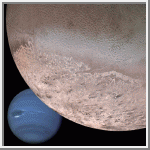28 June 1998
Global Warming Detected on Triton
 There may not be much industrial pollution on Neptune's largest moon, but things are hotting up nonetheless...
There may not be much industrial pollution on Neptune's largest moon, but things are hotting up nonetheless...
The Earth is not alone in suffering global warming. According to observations made by NASA's Hubble Space Telescope and several ground-based instruments, temperatures on Neptune's largest moon have increased dramatically since the Voyager space probe swung by in 1989. So much so, in fact, that Triton's surface of frozen nitrogen is turning into gas, making its thin atmosphere denser by the day.
"At least since 1989, Triton has been undergoing a period of global warming," confirms astronomer James Elliot, professor of Earth, Atmospheric and Planetary Sciences at Massachusetts Institute of Technology. "Percentage-wise, it's a very large increase."
Elliot and colleagues from the Lowell Observatory and Williams College report their findings in the June 25 issue of the journal Nature. Triton's 5 percent increase on the absolute temperature scale from about -392 to -389 degrees Fahrenheit would be like the Earth experiencing a jump of some 22 degrees Fahrenheit in just nine years.
There are two possible explanations for the moon's warmer weather. One is that the frost pattern on Triton's surface may have changed over the years, absorbing more and more of the sun's warmth. The other is that changes in reflectivity of Triton's ice may have caused it to absorb more heat.
About the same size and density as Pluto, Triton is thirty times as far from the sun as the Earth. It is known to be extremely cold and gusty, with wind speeds close to the speed of sound. Its atmosphere is composed mostly of molecular nitrogen, and its terrain varies between icy regions and bare spots. Quips Elliot: "When you're so cold, global warming is a welcome trend."
Picture courtesy of NASA/JPL
